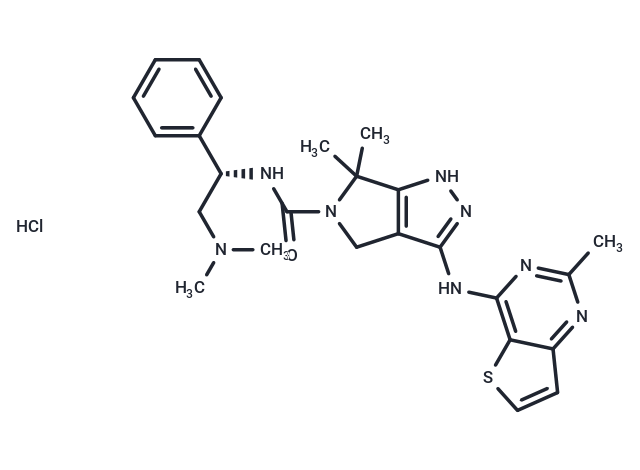Shopping Cart
- Remove All
 Your shopping cart is currently empty
Your shopping cart is currently empty


| Pack Size | Price | Availability | Quantity |
|---|---|---|---|
| 2 mg | $30 | In Stock | |
| 5 mg | $44 | In Stock | |
| 10 mg | $72 | In Stock | |
| 25 mg | $115 | In Stock | |
| 50 mg | $211 | In Stock | |
| 100 mg | $332 | In Stock | |
| 1 mL x 10 mM (in DMSO) | $70 | In Stock |
| Description | PF-3758309 hydrochloride (PF-03758309 hydrochloride) , is a PAK4 inhibitor, is also a n orally bioavailable small-molecule inhibitor of p21-activated kinase 4 (PAK4) with potential antineoplastic activity. PF-3758309 hydrochloride binds to PAK4, inhibiting PAK4 activity and cancer cell growth. PAK4, a serine/threonine kinase belonging to the p21-activated kinase (PAK) family, is often upregulated in a variety of cancer cell types and plays an important role in cancer cell motility, proliferation, and survival. |
| Targets&IC50 | PAK3:99 nM (IC50), PAK1:13.7 nM (Ki), PAK2:190 nM (IC50), PAK4:18.7 nM (Ki), PAK4:2.7 nM (Kd), PAK6:17.1 nM (Ki), PAK5:18.1 nM (Ki) |
| Alias | PF-03758309 hydrochloride |
| Molecular Weight | 527.08 |
| Formula | C25H31ClN8OS |
| Cas No. | 1279034-84-2 |
| Storage | Powder: -20°C for 3 years | In solvent: -80°C for 1 year | Shipping with blue ice. | ||||||||||||||||||||||||||||||
| Solubility Information | DMSO: 45 mg/mL (85.37 mM) | ||||||||||||||||||||||||||||||
Solution Preparation Table | |||||||||||||||||||||||||||||||
DMSO
| |||||||||||||||||||||||||||||||

Copyright © 2015-2024 TargetMol Chemicals Inc. All Rights Reserved.